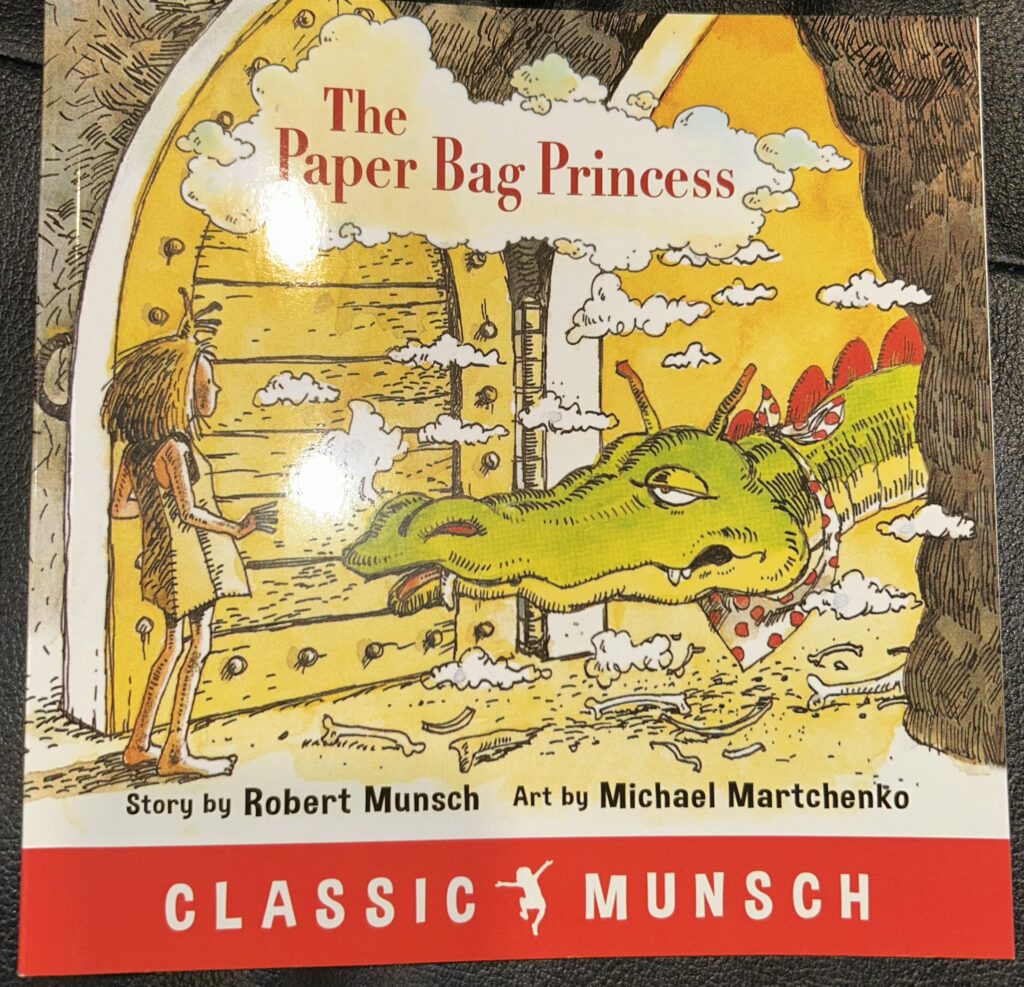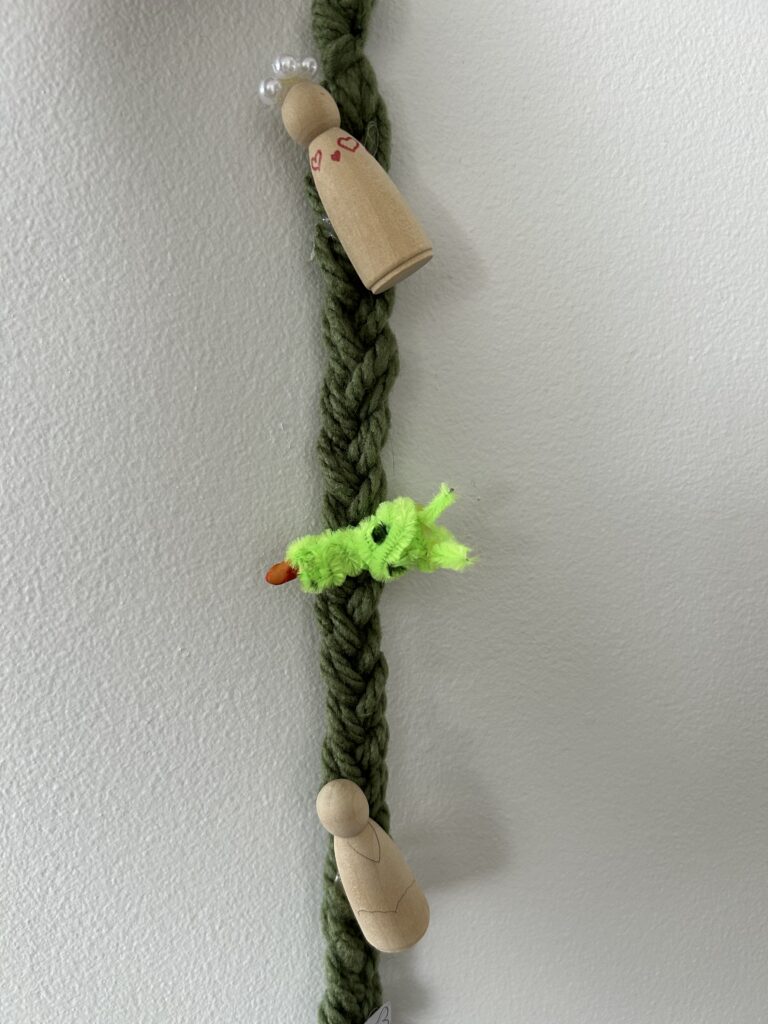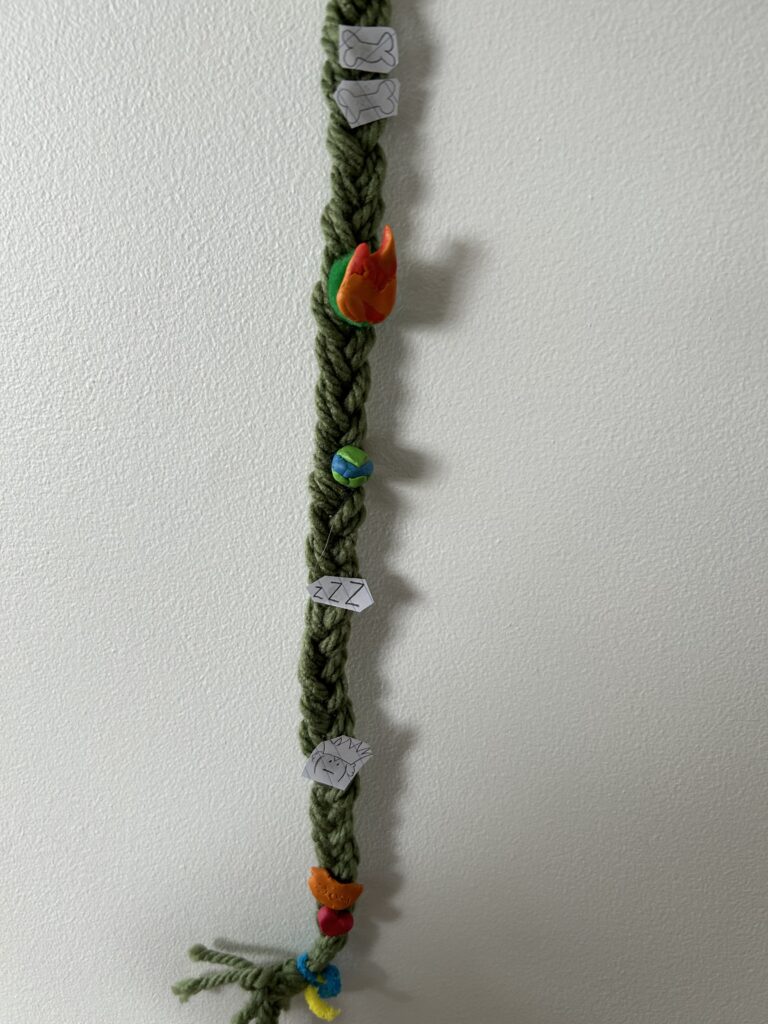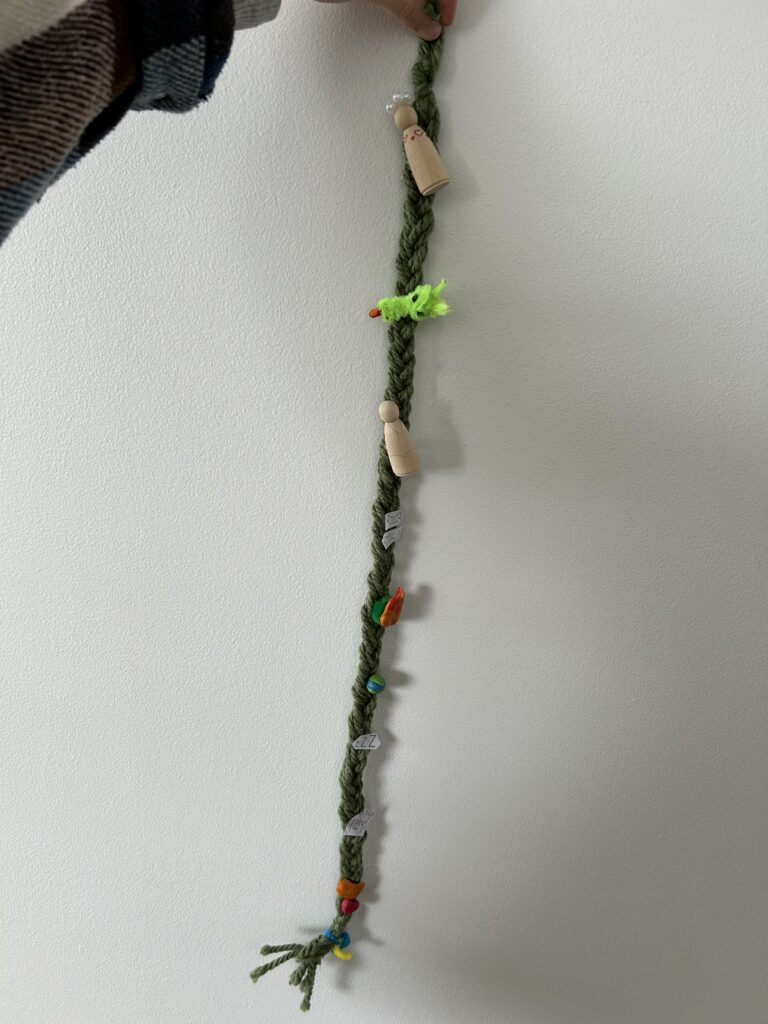Story Vines, an old African tradition of storytelling, is a creative way for students (or anyone) to retell a story that they have read or heard. The story is told orally, then retold through a sequence of artifacts representing different parts of the story, created by the reader. The goal of the story vine strategy is to help students develop the following skills
- “develops students’ understanding of story and sequence
- introduces students to new vocabulary
- links visual imagery with reading
- develops fluency in reading and talking” (Bright, 2021, pg. 91)
This strategy fits so well into English Language Arts and Arts Education from the BC Curriculum and can be altered for any grade. For example, for Grade 3 English Language Arts this activity covers the content story/text: elements of story and oral language strategies, the big idea “language and story can be a source of creativity and joy” and curricular competency “recognize the structure and elements of story.” There are many more ways you can connect this activity to the BC Curriculum which is great!
HOW TO: Step by Step
- Choose a book -> make sure to choose one that you love, know well, and that can be used year after year.
- Create a story vine -> use any material that can be braided easily for the “vine.” Make sure your braid is long and wide enough to fit any small artifacts on to it. The artifacts are used to represent different parts of the story and plot. Also, students can create their own artifacts by drawing them or finding images online or in magazines. *Side note: use a hot glue gun to make the artifacts stay in place and last longer.
- Read your chosen story out loud to your students -> be dramatic, use lots of expression, and make sure your reading is fluent.
- Retell the story, using your story vine -> retell the story by using your story vine and make sure to point out your artifacts while you do so. *Remember the story may sound different but the students should be able to make connections to phrases or vocabulary used throughout the original story.
- Have students find a book that they would like to make a story vine with -> recommend students to use a book that they might have already read or know well to support oral fluency. Story boards or having students flag pages in the book that are important or memorable to them allow the planning process of a story vine more manageable.
- Creating the story vine -> as the teacher it may be a good idea to walk the students through a tutorial on how to braid as some may not know how to and may be a new task for them. When it comes to collecting artifacts for the story vine, you could send out a letter home to care givers or ask the students to bring in any craft materials that they may want to use but make sure to supply some as well as glue guns.
- Practice, Practice, Practice! -> give students time to practice their story vines so they can become comfortable and confident in their storytelling abilities. This can be done individually, in small groups etc.
- Share story vines -> have students present their story vines. This can be done as a presentation to the whole class, in small groups or to the teacher. (Bright, 2021, pg. 91-92)
Reference: Bright, Robin. (2021). Sometimes Reading is Hard : Using decoding, vocabulary, and comprehension strategies to inspire fluent, passionate, lifelong readers. Pembroke Publishers.
My very own STORY VINE
I had so much fun creating my very own story vine. It was my first time hearing about this type of storytelling, and I love it! I think it is such a fun and unique way to tell a story. My story vine was inspired by the book The Paper Bag Princess by Robert Munsch.

Below I have attached pictures of my story vine, and a description of each artifact and how it ties into the story.
How my vine story was made: I first read through the story and noted the parts I thought were important and made sure to write them down so I could refer to them later. I then started to create my vine, which I made out of braided yarn. I grabbed a long piece of yarn and folded it repeatedly until desired length. I cut the “loops” that were created by folding the yard and made sure the bottom had all long strings, no looped strings. After, I tied the top into a loop and began braiding until the vine was complete, then tied off the bottom so the braid would not unravel. Once my vine was complete I started collecting artifacts (supplied by my teacher – very kind of her.) I made sure my artifacts aligned with the important parts I picked out, so when I read my story vine I can understand exactly the part in the story I am trying to tell. Lastly, I glued the artifacts on using a glue gun and my story vine was complete!

Walking you through my story vine…
Artifact #1 (wooden girl): Princess Elizabeth all dressed up and being head over heals for Prince Ronald.
Artifact #2 (pipe-cleaner dragon): The dragon breaks into the castle and burns all of Princess Elizabeths clothes and steals Prince Ronald.
Artifact #3 (wooden girl): Princess Elizabeth has to dress in a paper bag as it is the only thing she could find that was not burnt.
Artifact #4 (bones): The bones represent the journey Princess Elizabeth took to find the dragon that burnt all her clothes, he left a trail of them behind.
Artifact #5 (fire): Princess Elizabeth tricked the dragon to tire him out so she could sneak into the dragons cave. She bet that he couldn’t burn up ten forests… well he did that and more, fifty forests. By the end he was out of fire…
Artifact #6 (world): Princess Elizabeth tricked the dragon again, by making him fly around the world as fast as he could to tire him out again.
Artifact #7 (zzZ): The dragon fell asleep from all the activities he got tricked into doing… this allowed Princess Elizabeth to sneak into the cave that was initially guarded by the dragon to go and find Princess Ronald.
Artifact #8 (grumpy Prince Ronald): Ronald being appalled by how Princess Elizabeth looks, her hair all tangled, smelling of ashes. He sends her away and asks her to return when she looks like a “real” princess.
Artifact #9 (clay that is engraved with the word “joy” and a clay heart): Princess Elizabeth told Prince Ronald he was a “bum”… and ran into the sunset with such JOY!


My story vine as a whole!
I cannot wait to bring this idea into my future classroom!
Leave a Reply
You must be logged in to post a comment.